Lead magnets are one of the most effective strategies for getting leads to a business—it’s in the name, after all. When done well, they can help you build a highly targeted email list.
The best part: lead magnets are, by and large, a passive way of generating leads. Depending on their complexity, of course, you’ll have to spend some time and effort upfront developing it. However, the payoff is more than worthwhile.
Below, we’ll explain what lead magnets are, how they benefit your marketing strategy, and how to create one in just five steps.
In this article
What Exactly is a Lead Magnet?
Lead magnets come in a wide variety of forms, but at their core, they’re valuable pieces of content offered to your target users in exchange for their email address.
Chances are you’ve come across them as an everyday consumer. For instance, retail and ecommerce brands often entice shoppers with a special coupon or offer; users need only share their email address to claim it.
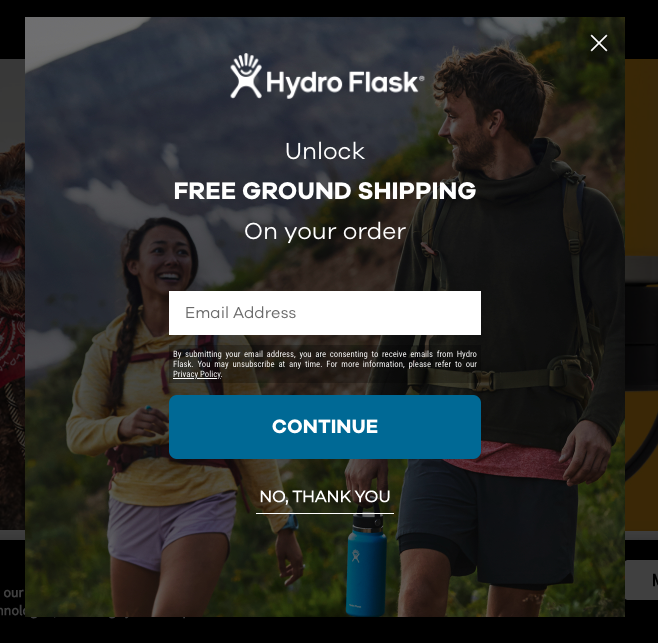
The lead magnet in the example from Hydro Flask above is free shipping. However, coupons and discounts aren’t the only things you can offer as lead magnets. They can be any useful resource—ideally, something that relates to your business and that your target customer will find valuable.
Some common lead magnets include:
- Ebooks
- White papers
- Calculators
- Checklists
- Cheat sheets
- Webinars
- Printables
- Templates
- Toolkits
Why should your marketing strategy include lead magnets?
Offering a lead magnet is a quick and passive way of collecting the contact information of users that may be interested in your product and message. If you can develop a quality lead magnet, the email list that results is more likely to lead to conversions than almost any other marketing resource.
Creating an effective lead magnet takes effort, though. After all, it must be genuinely useful and valuable in order for someone to willingly give up their personal information. Your lead magnet should also be relevant to your business’s niche or industry—otherwise, you’re offering a great resource in exchange for mediocre leads.
For these reasons, creating a strong lead magnet requires careful planning and execution.
How to Create an Effective Lead Magnet: 5 Steps
A poorly designed lead magnet can fail in plenty of ways. Ineffective lead magnets may be too broad, collecting emails of people who don’t care about your niche in particular. They can also give people a bad impression of your business if they look unprofessional.
When done right, a good lead magnet should positively reflect and represent your business as a trustworthy and authoritative company. How exactly can you do that? Follow these five steps to create an enticing and effective lead magnet.
1. Describe Your Ideal Customer
Before you even begin to plan your strategy for a lead magnet, take a step back. The goal of a lead magnet is to develop a high-quality email list—that is, leads that would realistically consider using your product or service.
Your first step should thus be to describe your target audience. When you know exactly who you want to reach, marketing becomes much simpler. That includes ideating and creating your lead magnet.
The more specific your ideal customer is, the better. Ask yourself questions like:
- What are their demographics? Think age, gender, location, income, education level, and even family size.
- What is their day-to-day life like? How do they spend their time, both in and out of work?
- What are their pain points? What’s causing them problems every day?
- How can your product or service solve one or more of their problems?
A great “ideal customer” might be a 50-year-old woman who works in marketing and has a large family; she doesn’t have time to keep her house clean, and your cleaning company can help her with weekly visits. This answers all of the questions above and provides a great jumping-off point for the next step.
2. Identify Your Value Proposition
Your value proposition is the reason for engaging with your material. When you’re creating a lead magnet, you need to provide something worthwhile for your potential leads. Otherwise, they’ll have no reason to download your offer.
When you’re identifying a value proposition, consider your ideal customer and their pain points; a great lead magnet should solve one of their problems. It doesn’t have to be a huge resource or something you could sell. Instead, think narrowly and offer a five-minute solution for something immediate and irritating.
Consider the client designed earlier—a 50-year-old marketer with a large family. If she’s struggling to keep her house clean, you could offer a video for cleaning a microwave in minutes or a guide about removing ground-in stains. Both options can solve an immediate problem and demonstrate your expertise.
3. Determine What Type of Lead Magnet to Create
After you’ve identified your value proposition, it’s time to choose a delivery method—as in, what kind of lead magnet to create.
Some value propositions can be delivered in multiple ways; for instance, almost all types of information can be conveyed in a video, article, or slideshow. Other value propositions are more nuanced and require some creativity.
Either way, when deciding what type of lead magnet to create, you should consider these two questions:
- What format aligns with your service?
- Does the format in question appeal to your target audience?
“Aligning” with your service involves keeping your messaging consistent. For example:
- If you already offer a lot of video content, then a one-minute video demonstrating how to do something is a great complement to your existing library.
- If you want to highlight your design skills, consider creating an infographic.
- Does your product or service require specific client info? Offer a quiz with personalized results.
Choosing the right type of lead magnet—whether that’s a checklist, recorded webinar, or something else—also depends in large part on your ideal client. If they’re a busy person, they might prefer consuming short and snappy videos. Or, if they’re highly educated and well-informed about a topic, they might appreciate more in-depth pieces of content, like an ebook.
4. Create a Quality Opt-In Page
Once you’ve hammered down your lead magnet’s value proposition and format, you can start developing a landing page for it—which is also known as an opt-in or squeeze page.
This is the page where people can choose to opt in to receive your lead magnet, and it’s the most important part of the process. Here, a potential lead decides to trust you with their email address.
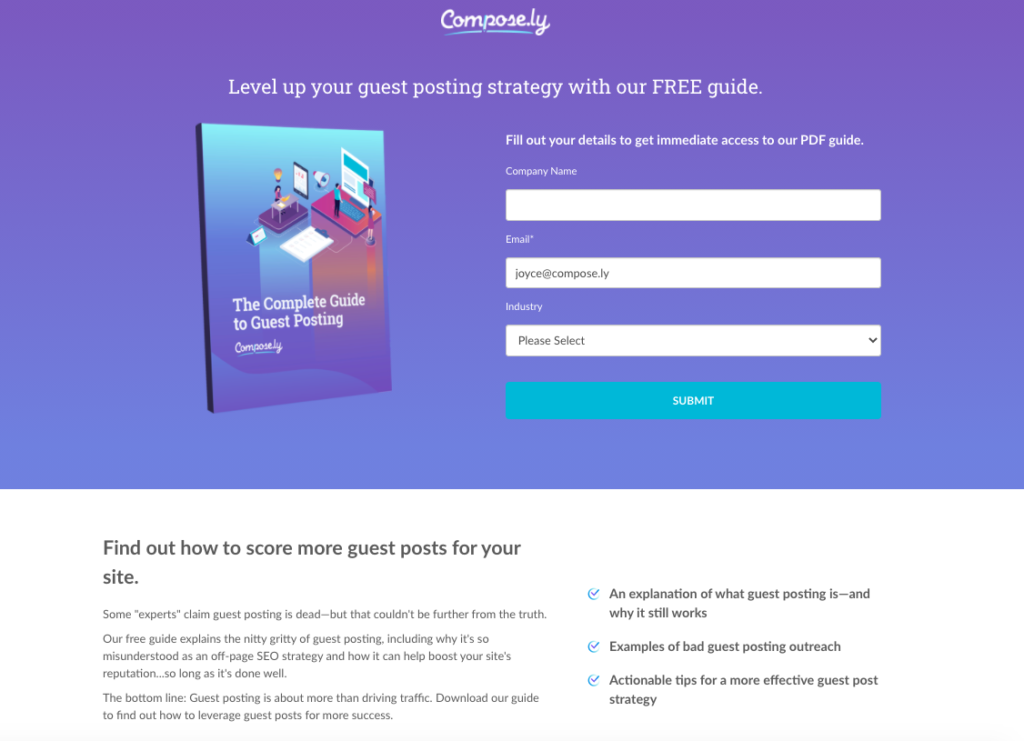
Just because someone’s landed on this page doesn’t mean they’ll necessarily submit their info. For this reason, you should put as much thought and effort into your opt-in page as you put into your lead magnet itself.
There are four important elements to a quality opt-in page:
- Your value proposition
- A breakdown of the benefits
- Quality visuals
- A call to action
Your value proposition can live in the page’s headline. Be descriptive, but keep it concise. Numbers and action words are great for catching the eye. The breakdown of benefits doesn’t have to be long, either. For short lead magnets, you can even mention the single important benefit in a subtitle.
Visuals vary from brand to brand. You want your page to appeal to your ideal client while directing the eye to the most important part of the page: the call to action.
Large buttons, clean designs, and contrasting colors are all excellent ways to guide the eye to the opt-in button. Your call to action should give your potential leads a concrete step to take: taking advantage of the lead magnet by giving you their email. It should also incite a sense of urgency. Try using words like “today,” “now,” and “free.” These help the reader make a quick decision instead of hesitating, and lock in your lead.
5. Put It All Together
Once you have your ideal client, value proposition, type of lead magnet, and an opt-in page, you’re ready to put together a top-quality lead magnet.
If you have the time and production skills, you can make a lead magnet yourself.
However, if time and resources are a concern, consider outsourcing the creation process to a qualified designer or writer. These experts have the skills to put together a professional, useful lead magnet that will give your leads a good impression—and such an investment can be more cost-effective than creating it yourself in the long run.
One lead magnet can generate leads for years; doing it right in the first place will ultimately save you both time and money.
Real-Life Examples of Enticing Lead Magnets
Learn best by example? If that’s the case, let these three awesome lead magnets serve as real-life inspiration for your own business.
MattressFirm’s Mattress Matcher Quiz
MattressFirm’s Mattress Matcher quiz is an excellent lead magnet example that captures all five aspects of a quality lead magnet.
For one, it offers a clear value proposition: Users will receive personalized suggestions for mattresses according to their specific needs and preferences.
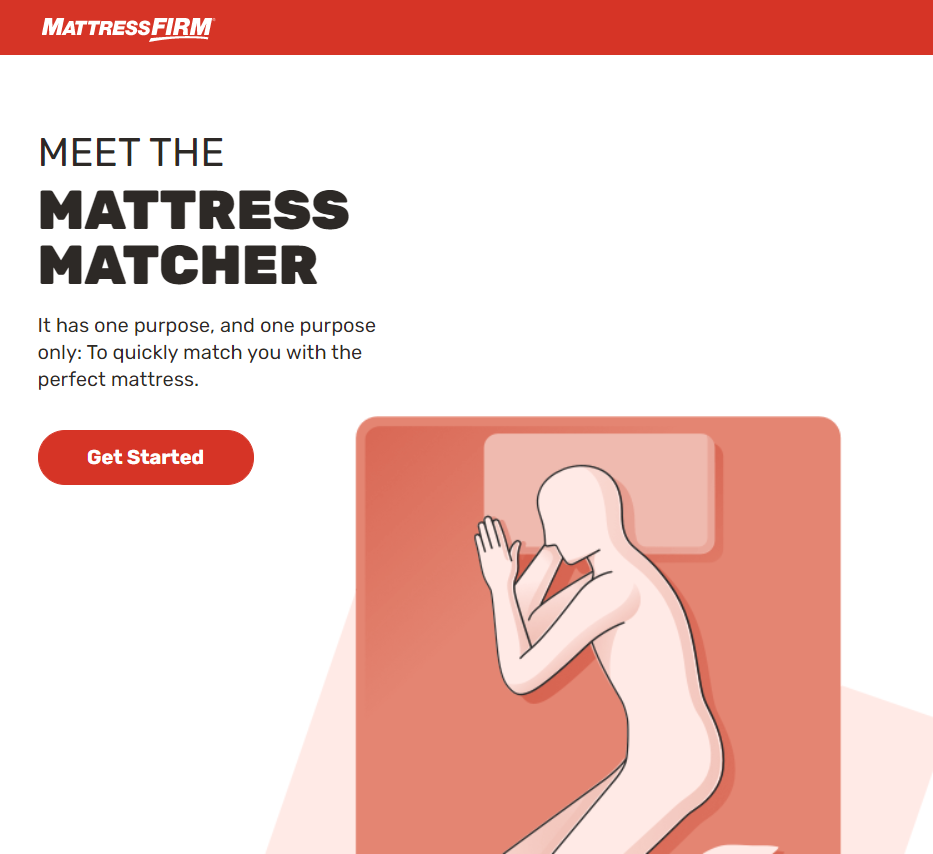
To that end, the quiz is focused on finding out more about the potential lead, with questions like “What common mattress problem is most problematic for you?” and “What size mattress are you looking for?” Not only does this help MattressFirm give its leads personalized results, it also creates a segmented email list.
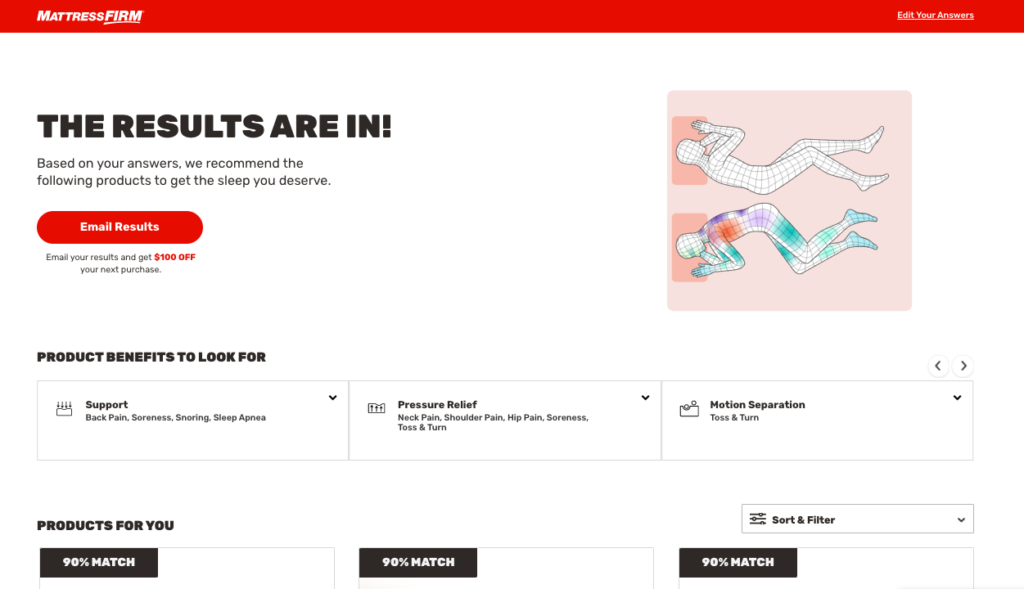
The quiz then ends with a simple but effective opt-in page—one that showcases mattress recommendations and offers a $100 discount if quiz-takers get their results emailed to them. From the user’s standpoint, it feels like double the value, since they’ll receive both their quiz results and a coupon in exchange for just their email address.
InvoiceBerry’s Free Ebook
InvoiceBerry is an invoicing company that strives to help small businesses track their finances quickly and effectively. It offers a free ebook as a lead magnet: Small Business Finance 101.
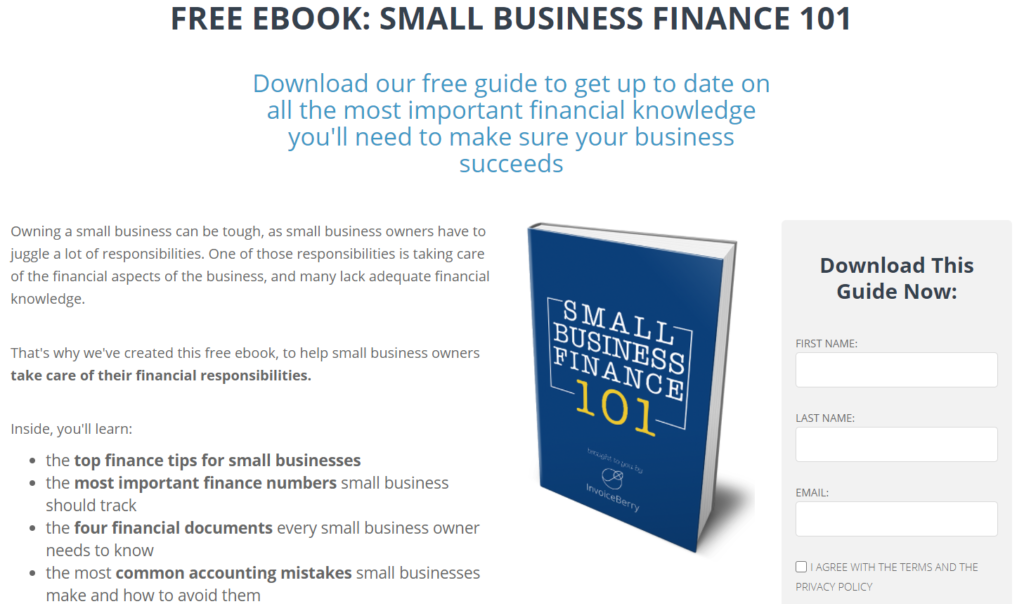
This free guide is aimed at a specific demographic: small business owners who aren’t confident in their finance skills, and may not feel comfortable keeping track of their income or expenses themselves.
The guide covers important financial topics such as the important numbers a business should track and accounting mistakes to avoid. It’s useful for business owners, of course; however, it also emphasizes the sheer amount of information that needs to be recorded and the consequences of certain financial mistakes. As a result, not only does the ebook demonstrate InvoiceBerry’s expertise, it encourages the lead to consider using a professional service like InvoiceBerry.
This opt-in page is heavy on the benefits of the ebook and even mentions that the ebook may help the reader get paid faster. In this way, it reminds readers of their pain points, offers relief, and implies that not reading the book will make the pain worse. This is a potent combination of motivation for potential leads.
Venngage’s Pre-Recorded Webinars
Imagine you’re looking to improve your skills in a particular subject. You read blog posts for tips, and one particular post offers a free webinar related to the very subject you’re trying to learn about. To save your spot, you just need to register with your email.
This is exactly what Venngage does with its webinars. The infographic-making company’s blog posts link to relevant lead magnets, presenting them as supplementary information that can be consumed in a different way (video). One example is its webinar about accessible design.
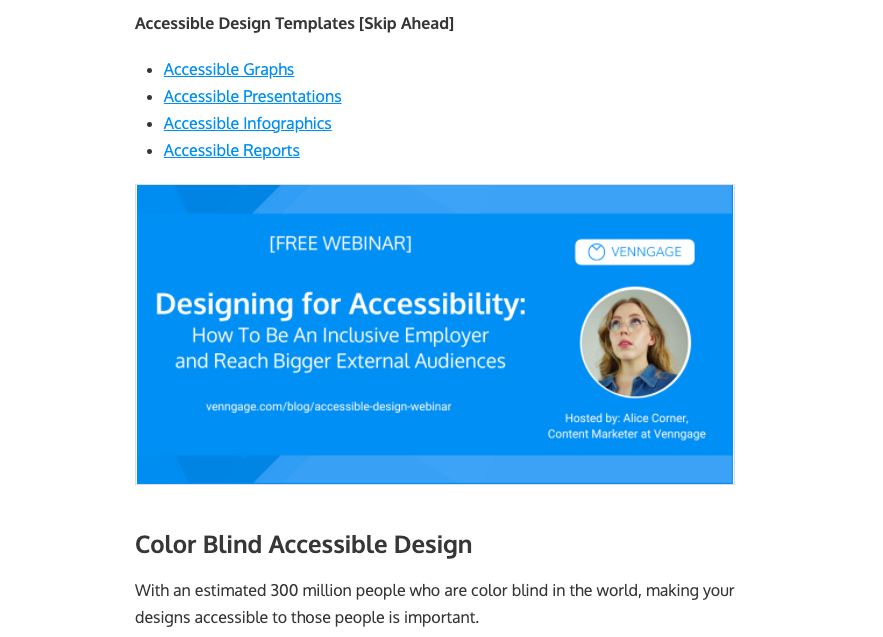
The webinar gives off the impression of being live with a CTA like “Save your spot” on its opt-in page.
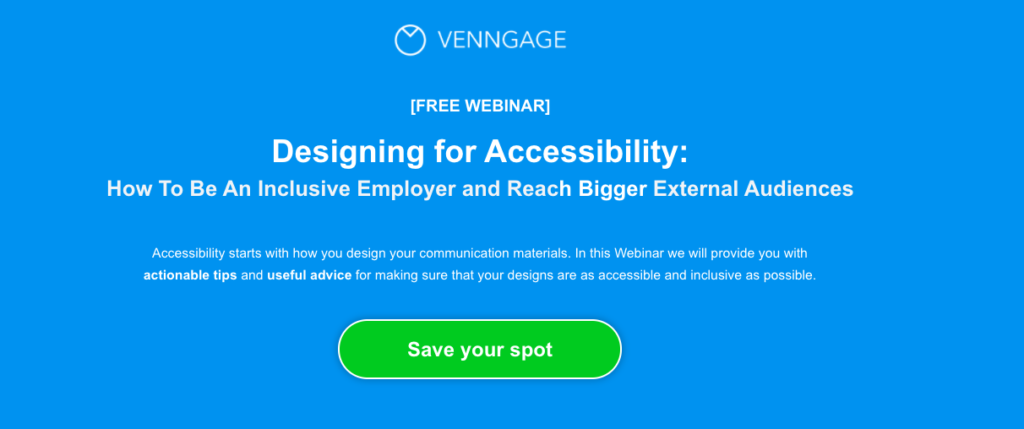
In reality, it’s pre-recorded—so Venngage’s team doesn’t have to fuss over the logistics of setting up a live webinar. Instead, using WebinarJam, Venngage’s team can automate replays of its webinar but still run a live Q&A chat.
Because any new lead can sign up and access the recording regardless of when they stumble upon the squeeze page, this strategy is far more sustainable than hosting a one-off webinar.
Conclusion
Lead magnets are a powerful lead generation tool. In short, they demonstrate your brand’s expertise, help your potential leads solve a problem, and build a quality email list along the way.
Of course, not all lead magnets are created equal. Done poorly, your lead magnet will either net zero leads or only lure low-quality ones. That’s why it’s crucial to create a top-notch lead magnet.
Identifying your ideal client and value proposition is paramount to creating a lead magnet that leads to conversions. Make these choices thoughtfully, and you’ll develop a lead magnet that brings in new clients for months—even years—to come, without any further investment.



